Supply and Demand Analysis for Designing Sustainable National Earth Observation-Based Services for Coastal Area Monitoring
Abstract
1. Introduction
- Sharing coastal data and information for use and re-use to give added value to existing products. This goal could be achieved if data and information were easy to access: a national access point to coastal data and information would provide a complete picture of the available data.
- Harmonizing local coastal products across MSs and neighboring countries with the goal of getting a homogeneous picture of the whole basin. Moreover, the availability of homogeneous products favors the development of the market and attracts large-scale investments.
- Identifying user needs starting from the institutional market to help EU Member States with the use of EO products for institutional tasks, thereby also helping the development of commercial downstream products.
- Fostering a larger and recognized use of EO for environmental reporting, for instance, through a regulatory action that promotes the uptake by public institutions and private companies of EO data.
- Promoting the planning of private future investments by clearly distinguishing between free product segments and those left to commercial services.
2. Materials and Methods
2.1. The Consultation Boards and Questionnaires
2.2. Analyses of the Questionnaires
3. Results
3.1. The Users’ Needs for Monitoring Coastal Zone Changes
3.2. The Available Coastal Services in Italy on Both National and Sub-National Scales
3.2.1. In-Situ Data
3.2.2. Remote Sensing-Based Data and Services
3.2.3. Model-Based Products and Services
3.2.4. Data Archives
3.3. Analysis of Coastal User Needs and Gaps
4. Discussion
5. Conclusions
Author Contributions
Funding
Institutional Review Board Statement
Informed Consent Statement
Data Availability Statement
Acknowledgments
Conflicts of Interest
References
- Wolff, C.; Vafeidis, A.T.; Muis, S.; Lincke, D.; Satta, A.; Lionello, P.; Jimenez, J.A.; Conte, D.; Hinkel, J. A Mediterranean coastal database for assessing the impacts of sea-level rise and associated hazards. Sci. Data 2018, 5, 180044. [Google Scholar] [CrossRef] [PubMed]
- Melet, A.; Le Traon, P.-Y.; Tonani, M.; Reppucci, A.; Lux, M.; Silovic, T. Copernicus Marine Service: Coastal Extension. In Proceedings of the EGU General Assembly 2023, Vienna, Austria, 24–28 April 2023; p. EGU23-11148. [Google Scholar] [CrossRef]
- Zanin, G.M.; Muwafu, S.P.; Costa, M.M. Nature-based solutions for coastal risk management in the Mediterranean basin: A literature review. J. Environ. Manag. 2024, 356, 120667. [Google Scholar]
- Borriello, A.; Calvo Santos, A.; Codina López, L.; Feyen, L.; Gaborieau, N.; Garaffa, R.; Ghiani, M.; Guillén, J.; Mc Govern, L.; Norman, A.; et al. The EU Blue Economy Report 2024. Ufficio delle Pubblicazioni dell’Unione Europea. 2024. Available online: https://data.europa.eu/doi/10.2771/186064 (accessed on 10 January 2025).
- Plan Bleu. Blue Economy in the Mediterranean: Case Studies, Lessons and Perspectives; Plan Bleu Paper: Marseille, France, 2020. [Google Scholar]
- Politi, E.; Paterson, S.K.; Scarrott, R.; Tuohy, E.; O’mahony, C.; Cámaro-García, W.C.A. Earth observation applications for coastal sustainability: Potential and challenges for implementation. Anthr. Coasts 2019, 2, 306–329. [Google Scholar] [CrossRef]
- Carranza, M.L.; Drius, M.; Marzialetti, F.; Malavasi, M.; de Francesco, M.C.; Acosta, A.T.R.; Stanisci, A. Urban expansion depletes cultural ecosystem services: An insight into a Mediterranean coastline. Rend. Lincei. Sci. Fis. Naturali 2020, 31, 103–111. [Google Scholar] [CrossRef]
- Conte, A.; Zappitelli, I.; Fusaro, L.; Alivernini, A.; Moretti, V.; Sorgi, T.; Recanatesi, F.; Fares, S. Significant Loss of Ecosystem Services by Environmental Changes in the Mediterranean Coastal Area. Forests 2022, 13, 689. [Google Scholar] [CrossRef]
- Basconi, L.; Rova, S.; Stocco, A.; Pranovi, F. Ecosystem services for supporting coastal and marine resources management, an example from the Adriatic Sea (Central Mediterranean Sea). Ocean. Coast. Manag. 2023, 235, 106486. [Google Scholar] [CrossRef]
- de Andrés, M.; Muñoz, J.M.B.; Onetti, J.G.; Zuniga, L.D.C. Mapping services for an ecosystem based management along the Andalusian coastal zone (Spain). Ocean Coast. Manag. 2023, 231, 106402. [Google Scholar] [CrossRef]
- Melet, A.; Teatini, P.; Le Cozannet, G.; Jamet, C.; Conversi, A.; Benveniste, J.; Almar, R. Earth Observations for Monitoring Marine Coastal Hazards and Their Drivers. Surv. Geophys. 2020, 41, 1489–1534. [Google Scholar] [CrossRef]
- Liu, C.; Liu, G.; Yang, Q.; Luo, T.; He, P.; Franzese, P.P.; Lombardi, G.V. Emergy-based evaluation of world coastal ecosystem services. Water Res. 2021, 204, 117656. [Google Scholar] [CrossRef]
- Miura, Y.; Qureshi, H.; Ryoo, C.; Dinenis, P.C.; Li, J.; Mandli, K.T.; Deodatis, G.; Bienstock, D.; Lazrus, H.; Morss, R. A methodological framework for determining an optimal coastal protection strategy against storm surges and sea level rise. Nat. Hazards 2021, 107, 1821–1843. [Google Scholar] [CrossRef]
- Visbeck, M.; Kronfeld-Goharani, U.; Neumann, B.; Rickels, W.; Schmidt, J.; van Doorn, E.; Matz-Lück, N.; Ott, K.; Quaas, M.F. Securing blue wealth: The need for a special sustainable development goal for the ocean and coasts. Mar. Policy 2014, 48, 184–191. [Google Scholar] [CrossRef]
- Hidalgo, M.; El-Haweet, A.E.; Tsikliras, A.C.; Tirasin, E.M.; Fortibuoni, T.; Ronchi, F.; Lauria, V.; Ben Abdallah, O.; Arneri, E.; Ceriola, L.; et al. Risks and adaptation options for the Mediterranean fisheries in the face of multiple climate change drivers and impacts. ICES J. Mar. Sci. 2022, 79, 2473–2488. [Google Scholar] [CrossRef]
- Monnier, B.; Pergent, G.; Valette-Sansevin, A.; Boudouresque, C.F.; Mateo, M.Á.; Pergent-Martini, C. The Posidonia oceanica matte: A unique coastal carbon sink for climate change mitigation and implications for management. Vie Milieu Life Environ. 2020, 70, hal-03342407. [Google Scholar]
- Hendriks, I.E.; Escolano-Moltó, A.; Flecha, S.; Vaquer-Sunyer, R.; Wesselmann, M.; Marbà, N. Mediterranean seagrasses as carbon sinks: Methodological and regional differences. Biogeosciences 2022, 19, 4619–4637. [Google Scholar] [CrossRef]
- Mejjad, N.; Rossi, A.; Pavel, A.B. The coastal tourism industry in the Mediterranean: A critical review of the socio-economic and environmental pressures & impacts. Tour. Manag. Perspect. 2022, 44, 101007. [Google Scholar] [CrossRef]
- Mancini, M.S.; Barioni, D.; Danelutti, C.; Barnias, A.; Bračanov, V.; Capanna Piscè, G.; Chappaz, G.; Đuković, B.; Guarneri, D.; Lang, M.; et al. Anthropogenic Changes in a Mediterranean Coastal Wetland during the Last Century—The Case of Gialova Lagoon, Messinia, Greece. Water 2019, 11, 350. [Google Scholar] [CrossRef]
- Sesli, F.A. Mapping and monitoring temporal changes for coastline and coastal area by using aerial data images and digital photogrammetry: A case study from Samsun, Turkey. Int. J. Phys. Sci. 2010, 5, 1567–1575. [Google Scholar]
- Biondo, M.; Buosi, C.; Trogu, D.; Mansfield, H.; Vacchi, M.; Ibba, A.; Porta, M.; Ruju, A.; De Muro, S. Natural vs. Anthropic Influence on the Multidecadal Shoreline Changes of Mediterranean Urban Beaches: Lessons from the Gulf of Cagliari (Sardinia). Water 2020, 12, 3578. [Google Scholar] [CrossRef]
- Foti, G.; Barbaro, G.; Barillà, G.C.; Frega, F. Effects of Anthropogenic Pressures on Dune Systems—Case Study: Calabria (Italy). J. Mar. Sci. Eng. 2022, 10, 10. [Google Scholar] [CrossRef]
- Navarro-Pedreño, J.; Llorens, P.M. Changes in Mediterranean Coastline According to the Coastal Type and Land Cover under Climate Change: The Case of South-East Spain. J. Geogr. Res. 2023, 6, 34–47. [Google Scholar]
- OECD. Adapting to a Changing Climate in the Management of Coastal Zones; Policy Perspective, Environment Policy Paper No. 24; OECD Publishing: Paris, France, 2021. [Google Scholar] [CrossRef]
- Arabadzhyan, A.; Figini, P.; García, C.; González, M.M.; Lam-González, Y.E.; León, C.J. Climate change, coastal tourism, and impact chains–a literature review. Curr. Issues Tour. 2021, 24, 2233–2268. [Google Scholar] [CrossRef]
- Barnard, P.L.; Dugan, J.E.; Page, H.M.; Wood, N.J.; Hart, J.A.F.; Cayan, D.R.; Erikson, L.H.; Hubbard, D.M.; Myers, M.R.; Melack, J.M.; et al. Multiple climate change-driven tipping points for coastal systems. Sci. Rep. 2021, 11, 15560. [Google Scholar] [CrossRef] [PubMed]
- Cinner, J.E.; Caldwell, I.R.; Thiault, L.; Ben, J.; Blanchard, J.L.; Coll, M.; Diedrich, A.; Eddy, T.D.; Everett, J.D.; Folberth, C.; et al. Potential impacts of climate change on agriculture and fisheries production in 72 tropical coastal communities. Nat. Commun. 2022, 13, 3530. [Google Scholar] [CrossRef] [PubMed]
- Trégarot, E.; D’OLivo, J.P.; Botelho, A.Z.; Cabrito, A.; Cardoso, G.O.; Casal, G.; Cornet, C.C.; Cragg, S.M.; Degia, A.K.; Fredriksen, S.; et al. Effects of climate change on marine coastal ecosystems – A review to guide research and management. Biol. Conserv. 2024, 289, 110394. [Google Scholar] [CrossRef]
- Roukounis, C.N.; Tsihrintzis, V.A. Climate Change Adaptation Strategies for Coastal Resilience: A Stakeholder Surveys. Water 2024, 16, 1519. [Google Scholar] [CrossRef]
- UNEP/MAP/PAP. 2008. Protocol on Integrated Coastal Zone Management in The Mediterranean (Priority Actions Programme Regional Activity Centre, Split, 2008). Available online: https://wedocs.unep.org/bitstream/handle/20.500.11822/35671/08IG18_Final_Act_iczm_eng.pdf (accessed on 11 June 2025).
- Filipponi, F.; Valentini, E.; Xuan, A.N.; Guerra, C.A.; Wolf, F.; Andrzejak, M.; Taramelli, A. Global MODIS fraction of green vegetation cover for monitoring abrupt and gradual vegetation changes. Remote Sens. 2018, 10, 653. [Google Scholar] [CrossRef]
- Almar, R.; Stieglitz, T.; Addo, K.A.; Ba, K.; Ondoa, G.A.; Bergsma, E.W.J.; Bonou, F.; Dada, O.; Angnuureng, D.; Arino, O. Coastal zone changes in West Africa: Challenges and opportunities for satellite earth observations. Surv. Geophys. 2023, 44, 249–275. [Google Scholar] [CrossRef]
- Psomiadis, E.; Diakakis, M.; Soulis, K.X. Combining SAR and Optical Earth Observation with Hydraulic Simulation for Flood Mapping and Impact Assessment. Remote Sens. 2020, 12, 3980. [Google Scholar] [CrossRef]
- Righini, M.; Gatti, I.; Taramelli, A.; Arosio, M.; Valentini, E.; Sapio, S.; Schiavon, E. Integrated Flood Impact and Vulnerability Assessment Using a Multi-Sensor Earth Observation Mission with the Perspective of an Operational Service in Lombardy, Italy. Land 2024, 13, 140. [Google Scholar] [CrossRef]
- Velegrakis, A.F.; Chatzistratis, D.; Chalazas, T.; Armaroli, C.; Schiavon, E.; Alves, B.; Grigoriadis, D.; Hasiotis, T.; Ieronymidi, E. Earth observation technologies, policies and legislation for the coastal flood risk assessment and management: A European perspective. Anthr. Coasts 2024, 7, 3. [Google Scholar] [CrossRef]
- Taramelli, A.; Lissoni, M.; Piedelobo, L.; Schiavon, E.; Valentini, E.; Xuan, A.N.; González-Aguilera, D. Monitoring Green Infrastructure for Natural Water Retention Using Copernicus Global Land Products. Remote Sens. 2019, 11, 1583. [Google Scholar] [CrossRef]
- Agrillo, E.; Filipponi, F.; Pezzarossa, A.; Casella, L.; Smiraglia, D.; Orasi, A.; Attorre, F.; Taramelli, A. Earth Observation and Biodiversity Big Data for Forest Habitat Types Classification and Mapping. Remote Sens. 2021, 13, 1231. [Google Scholar] [CrossRef]
- Vandelli, V.; Sarkar, N.; Micallef, A.S.; Soldati, M.; Rizzo, A. Coastal inundation scenarios in the north-eastern sector of the Island of Gozo (Malta, Mediterranean Sea) as a response to sea level rise. J. Maps 2022, 19, 2145918. [Google Scholar] [CrossRef]
- Androulidakis, Y.; Makris, C.; Mallios, Z.; Krestenitis, Y. Sea level variability and coastal inundation over the northeastern Mediterranean Sea. Coast. Eng. J. 2023, 65, 514–545. [Google Scholar] [CrossRef]
- Meli, M.; Camargo, C.M.L.; Olivieri, M.; Slangen, A.B.A.; Romagnoli, C. Sea-level trend variability in the Mediterranean during the 1993–2019 period. Front. Mar. Sci. 2023, 10, 1150488. [Google Scholar] [CrossRef]
- Wu, W.; Yang, Z.; Tian, B.; Huang, Y.; Zhou, Y.; Zhang, T. Impacts of coastal reclamation on wetlands: Loss, resilience, and sustainable management. Estuarine, Coast. Shelf Sci. 2018, 210, 153–161. [Google Scholar] [CrossRef]
- Rojas, C.; Munizaga, J.; Rojas, O.; Martínez, C.; Pino, J. Urban development versus wetland loss in a coastal Latin American city: Lessons for sustainable land use planning. Land Use Policy 2019, 80, 47–56. [Google Scholar] [CrossRef]
- Tomaselli, V.; Mantino, F.; Tarantino, C.; Albanese, G.; Adamo, M. Changing landscapes: Habitat monitoring and land transformation in a long-time used Mediterranean coastal wetland. Wetl. Ecol. Manag. 2022, 31, 31–58. [Google Scholar] [CrossRef]
- Bonazza, A.; Bonora, N.; Duke, B.; Spizzichino, D.; Recchia, A.P.; Taramelli, A. Copernicus in support of monitoring, protection, and management of cultural and natural heritage. Sustainability 2022, 14, 2501. [Google Scholar] [CrossRef]
- Taramelli, A.; Valentini, E.; Righini, M.; Filipponi, F.; Geraldini, S.; Nguyen Xuan, A. Assessing Po River Deltaic Vulnerability Using Earth Observation and a Bayesian Belief Network Model. Water 2020, 12, 2830. [Google Scholar] [CrossRef]
- Morelli, A.; Taramelli, A.; Bozzeda, F.; Valentini, E.; Colangelo, M.A.; Cueto, Y.R. The disaster resilience assessment of coastal areas: A method for improving the stakeholders’ participation. Ocean Coast. Manag. 2021, 214, 105867. [Google Scholar] [CrossRef]
- Schiavon, E.; Taramelli, A.; Tornato, A.; Lee, C.M.; Luvall, J.C.; Schollaert Uz, S.; Townsend, P.A.; Cima, V.; Geraldini, S.; Nguyen Xuan, A.; et al. Maximizing societal benefit across multiple hyperspectral earth observation missions: A user needs approach. J. Geophys. Res. Biogeosciences 2023, 128, e2023JG007569. [Google Scholar] [CrossRef]
- European Environment Information and Observation Network (EIONET). 2025. Central Data Repository. Available online: https://cdr.eionet.europa.eu/help/WISE_SoE (accessed on 27 May 2025).
- El Serafy, G.; Mészáros, L.; Fernández, V.; Capet, A.; She, J.; Sotillo, M.G.; Melet, A.; Legrand, S.; Mourre, B.; Campuzano, F.; et al. EuroGOOS roadmap for operational coastal downstream services. Front. Mar. Sci. 2023, 10, 1177615. [Google Scholar] [CrossRef]
- Geraldini, S.; Bruschi, A.; Bellotti, G.; Taramelli, A. User needs analysis for the definition of operational coastal services. Water 2021, 13, 92. [Google Scholar] [CrossRef]
- Taramelli, A.; Tornato, A.; Magliozzi, M.L.; Mariani, S.; Valentini, E.; Zavagli, M.; Costantini, M.; Nieke, J.; Adams, J.; Rast, M. An Interaction Methodology to Collect and Assess User-Driven Requirements to Define Potential Opportunities of Future Hyperspectral Imaging Sentinel Mission. Remote Sens. 2020, 12, 1286. [Google Scholar] [CrossRef]
- Sharma, S.; Pandey, S.K. Revisiting requirements documentation techniques and challenges. In Advances in Intelligent Systems and Computing; Springer: Berlin/Heidelberg, Germany, 2020; pp. 793–802. [Google Scholar] [CrossRef]
- Ciliberti, S.A.; Fanjul, E.A.; Pearlman, J.; Wilmer-Becker, K.; Bahurel, P.; Ardhuin, F.; Arnaud, A.; Bell, M.; Berthou, S.; Bertino, L.; et al. Evaluation of operational ocean forecasting systems from the perspective of the users and the experts. State Planet 2023, 1-osr7, 2. [Google Scholar] [CrossRef]
- Bruschi, A.; Lisi, I.; De Angelis, R.; Querin, S.; Cossarini, G.; Di Biagio, V.; Salon, S.; Solidoro, C.; Fassina, D.; Ancona, S.; et al. Indexes for the assessment of bacterial pollution in bathing waters from point sources: The northern Adriatic Sea CADEAU service. J. Environ. Manag. 2021, 293, 112878. [Google Scholar] [CrossRef]
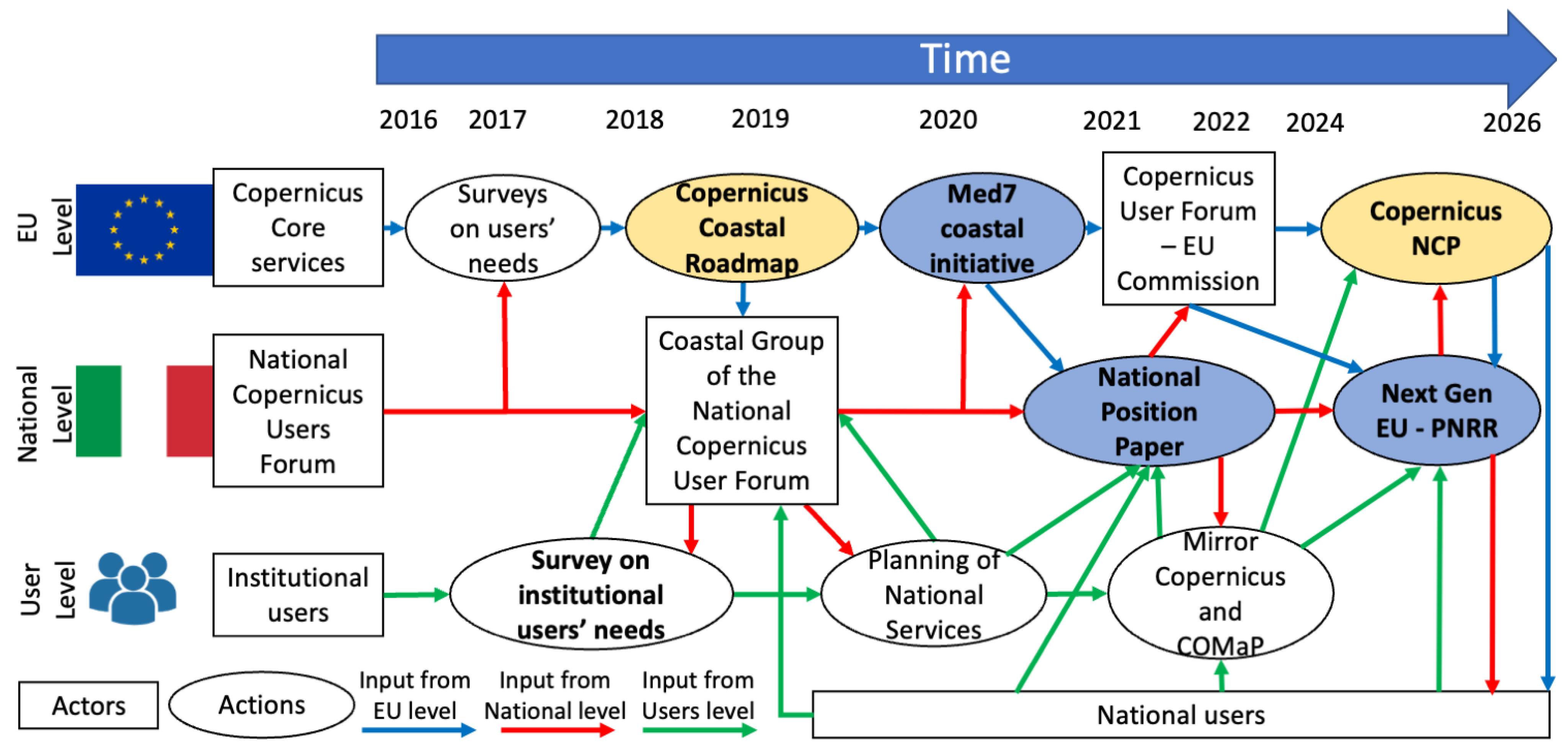
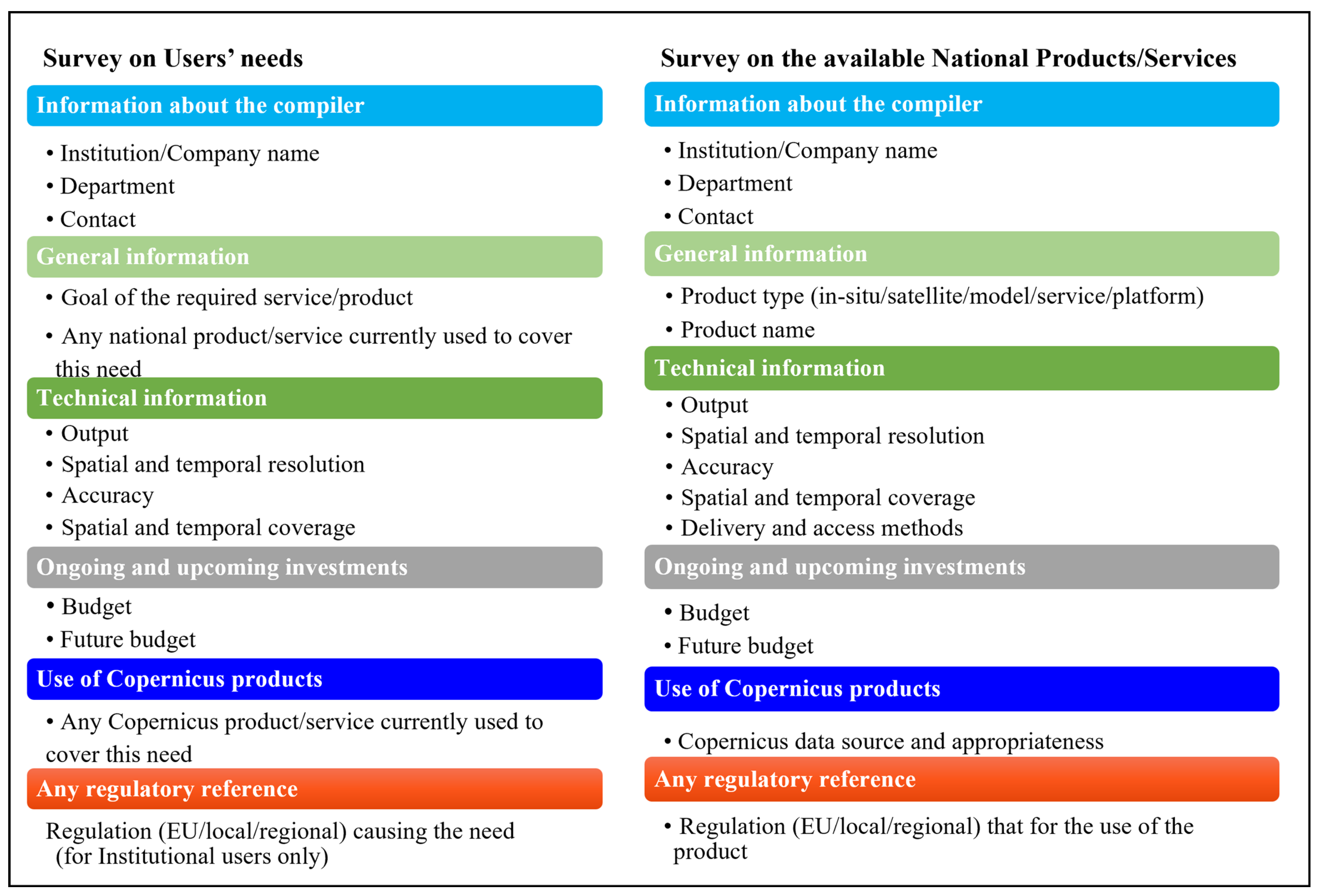
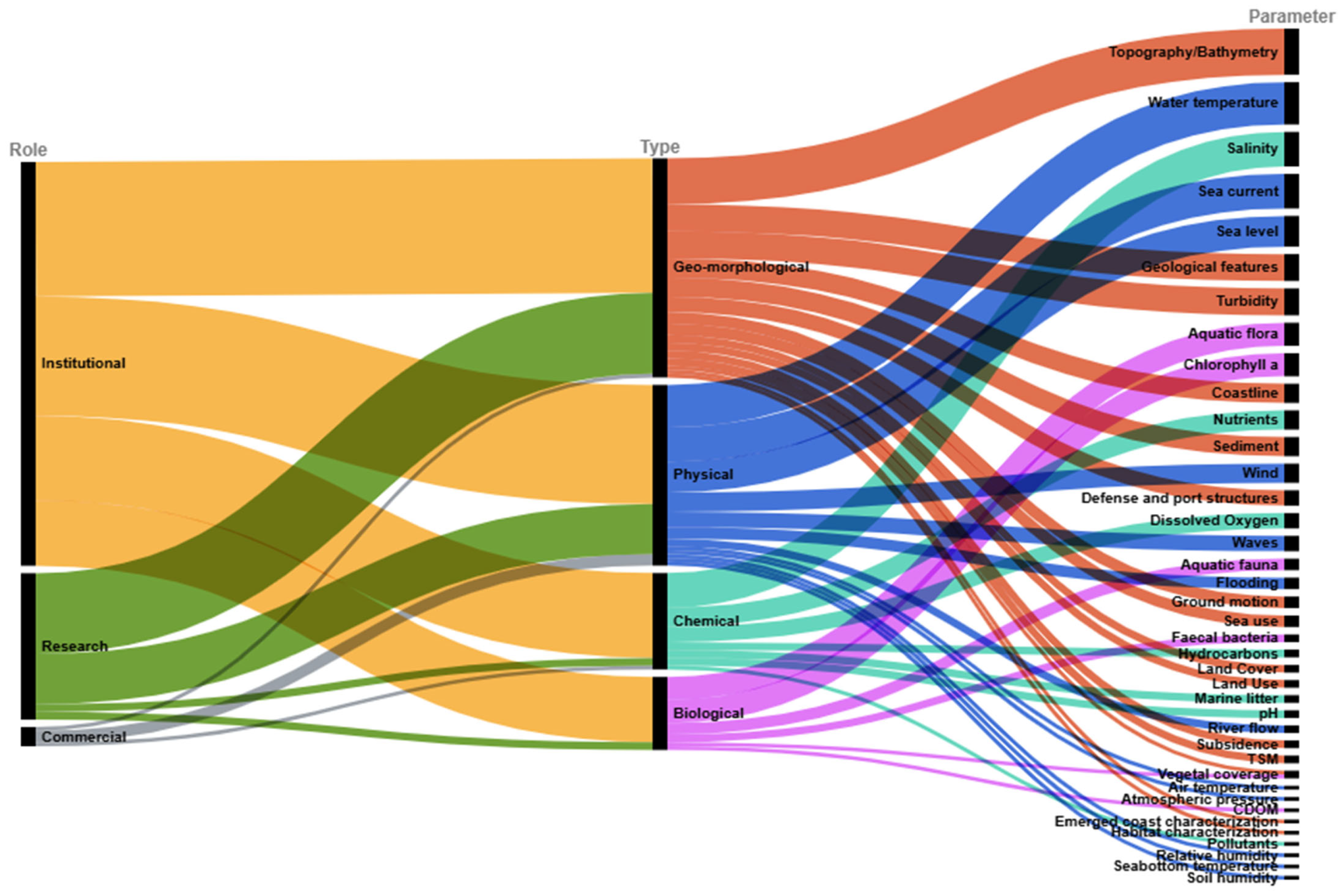
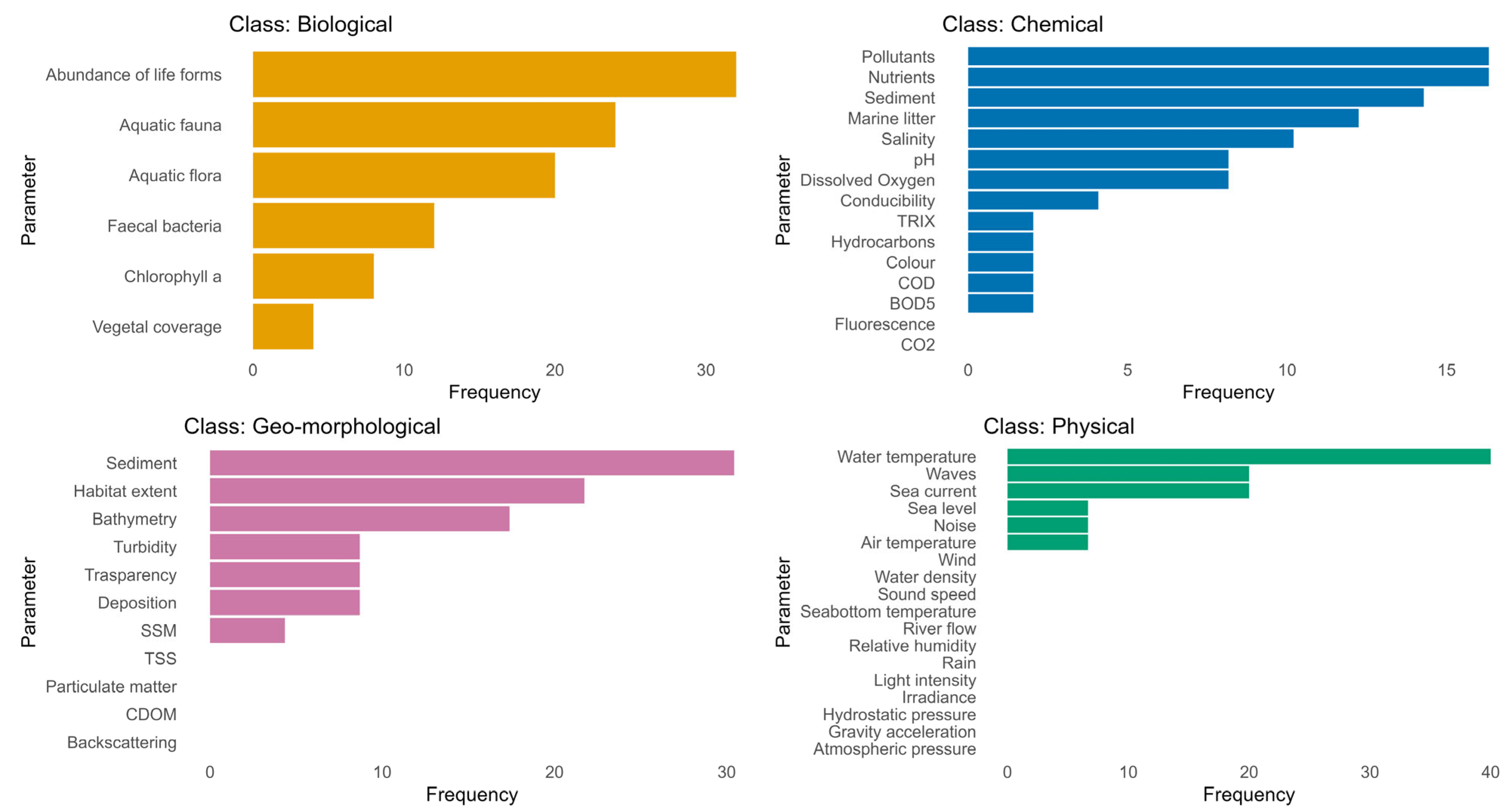
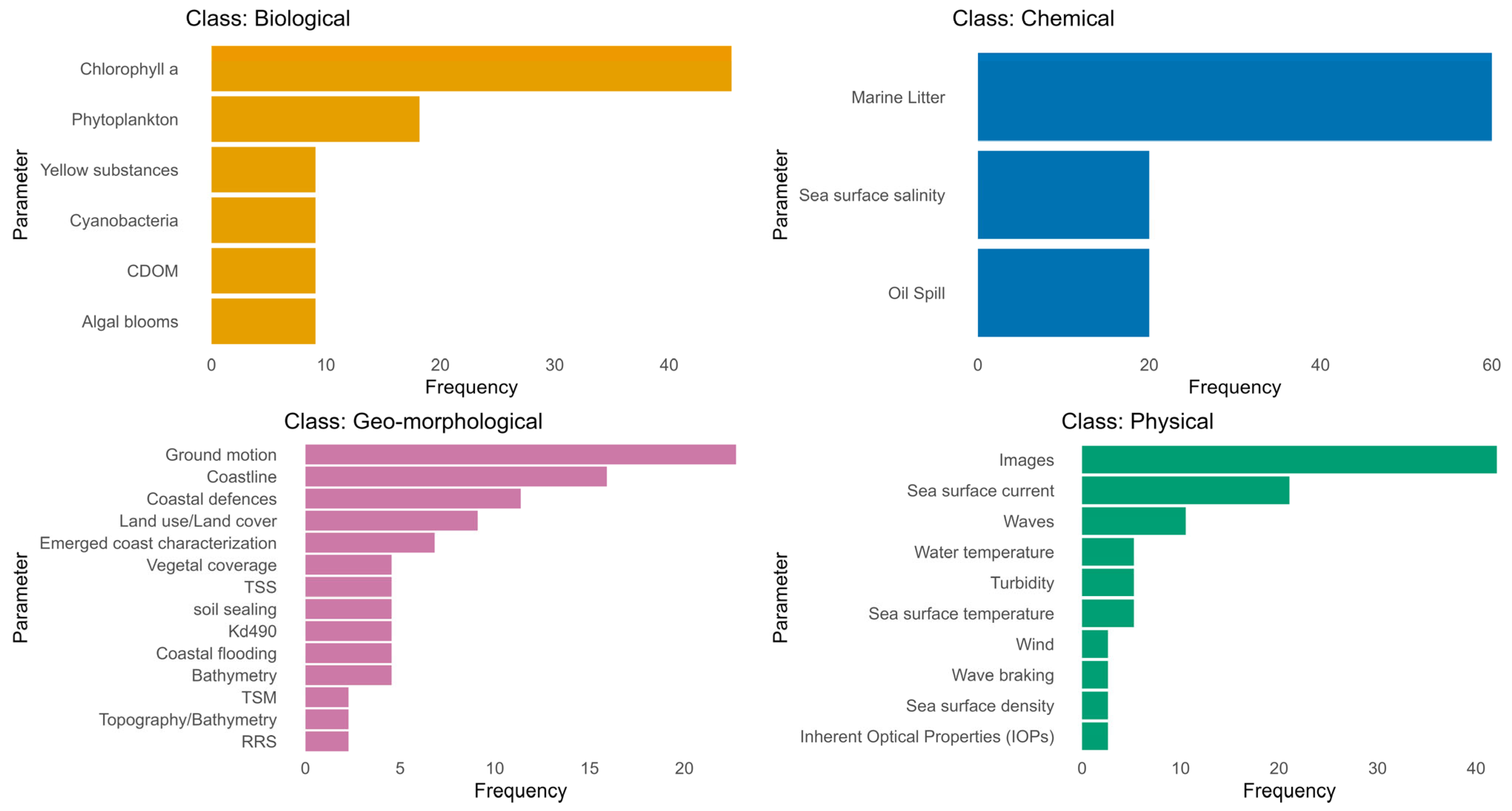
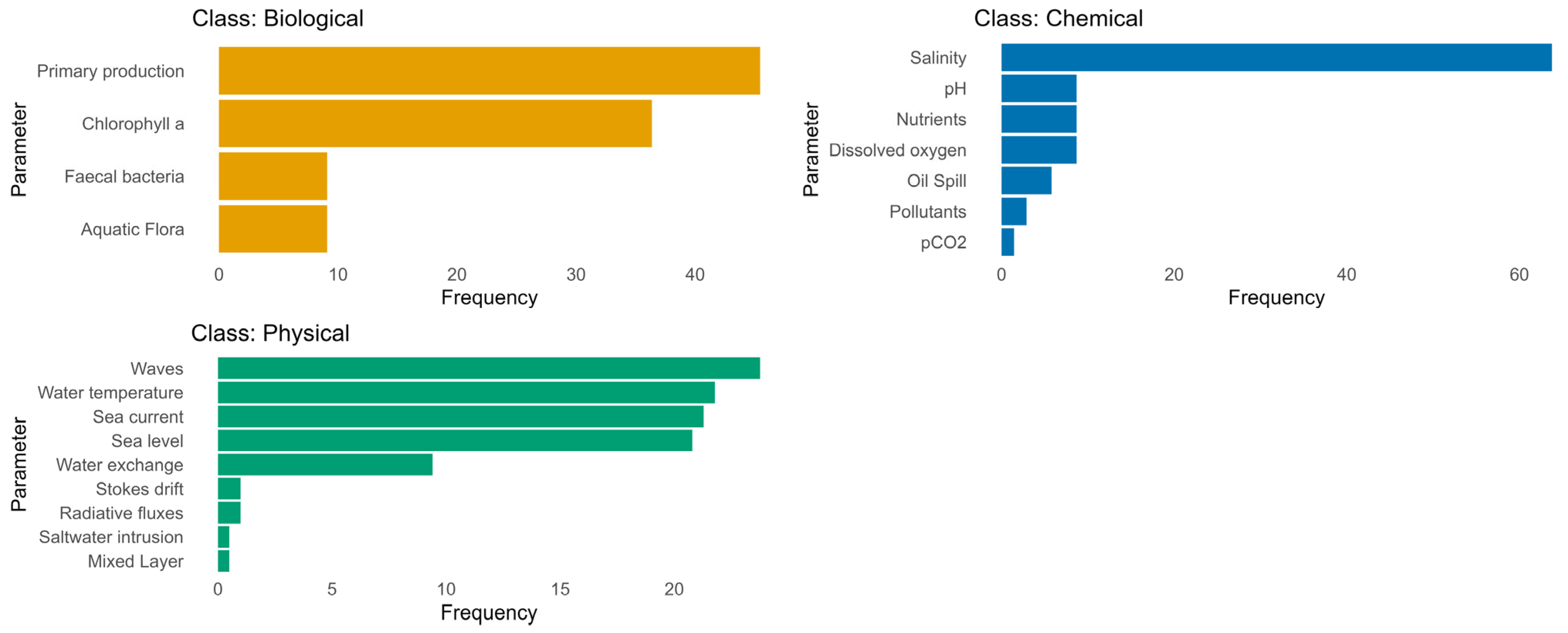
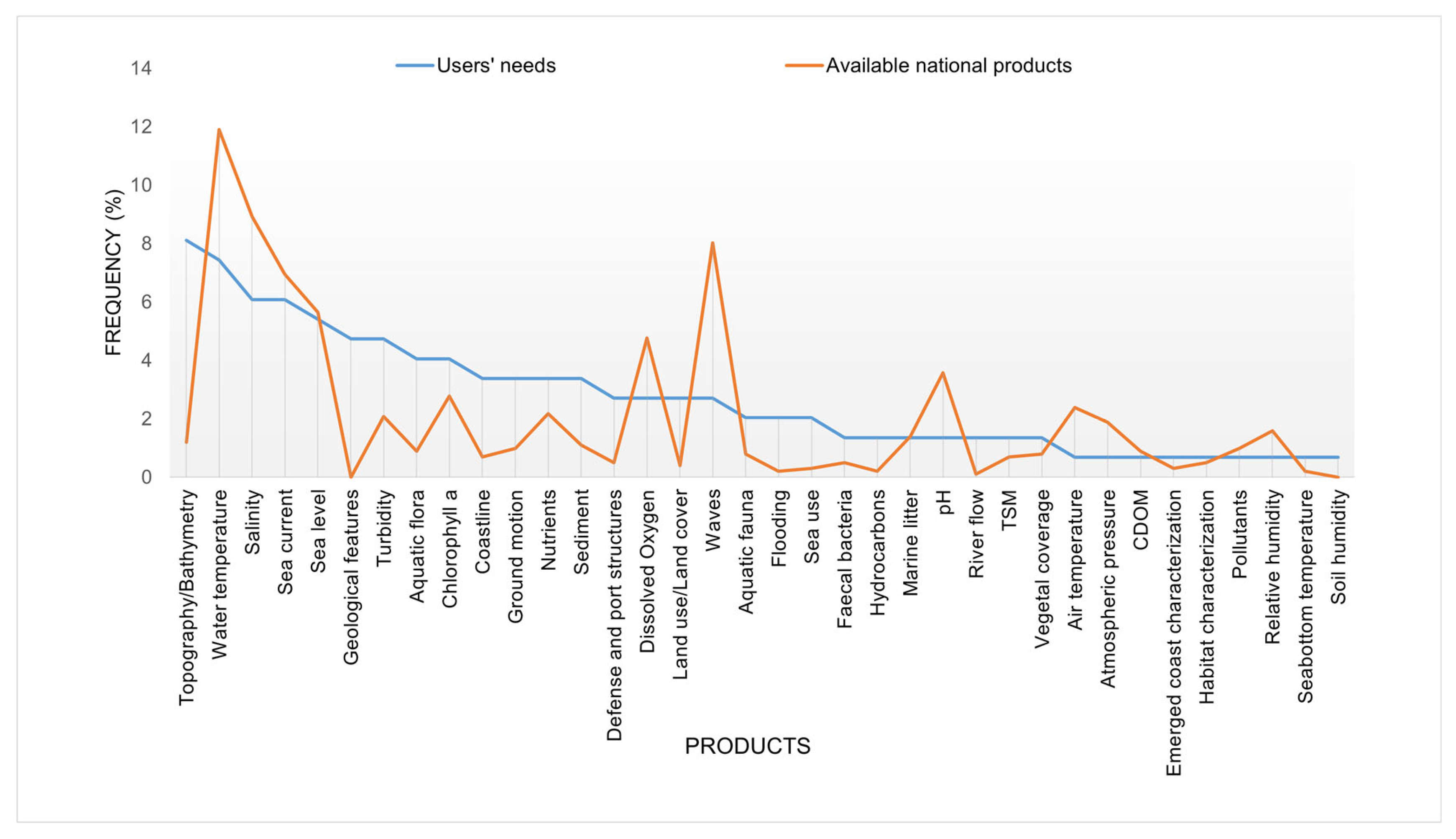
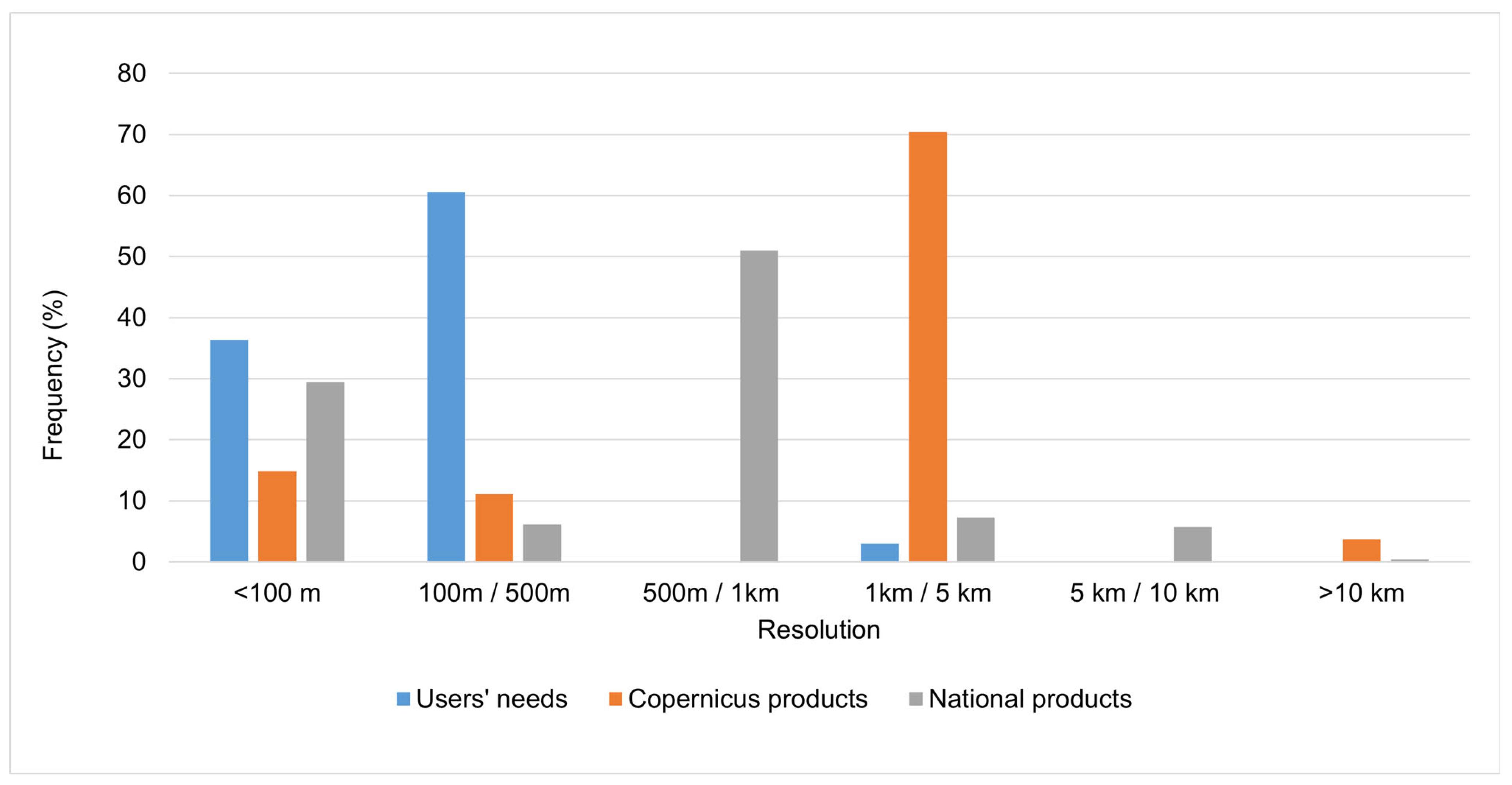

| Institution, Authority, Group Name | Acronym | Institution and Authority Participant | Task |
|---|---|---|---|
| Institutional users consulted by Geraldini et al., 2021 [50] | |||
| National Environmental Protection System | SNPA | Institute for Environmental Protection and Research (ISPRA) and Regional Coastal Agencies (ARPAs): Emilia Romagna (ARPAe), Liguria (ARPAL), Veneto (ARPAV), Puglia (ARPA Puglia) Friuli Venezia Giulia (ARPA FVG) | Environmental characterization, monitoring, and protection |
| National Table on Coastal Erosion | TNEC | Ministry of Environment and Protection of the Territory and the Sea-MATTM, Emilia Romagna, Marche, Tuscany, Calabria Regions and Environmental Agencies and the River Po and Calabria District Basin Authorities (ADBD) | Evaluation of the morphological variations of the coast, estimation of coastal erosion, and planning of management interventions |
| Coast Guard-Port Authority | MIT | Ministry of Infrastructure and Transport | Civil use of the sea regarding infrastructure, transport, and the environment |
| National System of Civil Protection | SNPC | Department of Civil Protection and Regional Systems | Risk prediction and prevention, relief to the affected populations, contrast and overcoming emergency and risk mitigation |
| Ministry of Defense | MD | Navy | Safety of human life, navigation and transport and of activities that take place in ports and along the coasts |
| Ministry of Agricultural, Food, and Forestry Policies | MIPAAF (former MIPAAFT) | Ministry of Agricultural, Food, Forestry, and Sea Fishing Policies | Sea fisheries and aquaculture management and policies |
| Ministry of Cultural Heritage and Activities and Tourism | MIBAC (former MIBACT) | Ministry of Cultural Heritage and Activities and Tourism | Monitoring and protection of cultural heritage and tourism management and policies |
| Users participating in the TFC | |||
| National Research Council | CNR | ||
| National Agency for new technologies, energy, and sustainable economic development | ENEA | ||
| National Institute of Oceanography and Applied Geophysics | OGS | ||
| National Institute of Geophysics and Volcanology | INGV | ||
| Laboratorio di monitoraggio e modellistica ambientale | LaMMA | ||
| EuroMediterranean Centre on Climate Change | CMCC | ||
| Copernicus Academy National Network | Copernicus Academy | UNIBAS-DIS, UNIVPM, UNICAL | |
| 7 Private sector users participating in the “coastal implementation group” organized by “Tavolo Valorizzazione” | |||
| Parameters | Definition |
|---|---|
| Biological | |
| Aquatic fauna | Faunal components of marine biota |
| Aquatic flora | Floral components of marine biota |
| CDOM | Colored dissolved organic matter: optically measurable component of dissolved organic matter in water |
| Chlorophyll a | Measurement of the amount of chlorophyll a in sea water, which indicates the amount of phytoplankton in the ocean. |
| Fecal bacteria | Measurement of the amount of fecal bacteria in sea water |
| Chemical | |
| Dissolved oxygen | Volume of oxygen that is contained in sea water |
| Hydrocarbons | Measurement of the amount of marine litter in sea water |
| Marine litter | Measurement of the amount of hydrocarbons in sea water |
| Nutrients | Sea water concentration of inorganic compounds essential for marine life |
| pH | Sea water pH |
| Pollutants | Measurement of the amount of pollutants in sea water |
| Salinity | Sea water salinity |
| Geo-morphological | |
| Coastline | Georeferenced map of the position of the coastline |
| Defense and port structures | Georeferenced map of the position of defense and port structures |
| Emergent coast characterization | Features of the emergent coasts, like steep slopes, wave notches, and high cliffs |
| Geological features | Details of coast’s surface, both terrestrial and marine |
| Ground motion | Motion of the ground recorded |
| Habitat characterization | Maps that depict and characterize the terrestrial and marine habitats in the coastal areas |
| Land cover | Coastal land cover information: (bio)physical description of the Earth’s surface (what overlays or currently covers the ground) |
| Land use | Socio-economic description (functional dimension) of coastal areas: areas used for residential, industrial, or commercial purposes |
| Sea use | Socio-economic description (functional dimension) of marine areas, e.g., mariculture, oil and gas exploration, and bottom trawling |
| Sediment | Information on the deposits of insoluble particles that have accumulated on the seafloor |
| Subsidence | Measure of coastal subsidence, i.e., sinking of the ground because of underground material movement |
| Topography/Bathymetry | Georeferenced maps of land topography/sea bathymetry |
| TSM | Total suspended matter: percentage of suspended particles (not dissolved) |
| Turbidity | The cloudiness, opacity, or thickness of water due to suspended matter |
| Vegetal coverage | Percentage of soil covered by green vegetation |
| Physical | |
| Air temperature | Measurement of air temperature |
| Atmospheric pressure | Measurement of atmospheric pressure, weight-per-unit area of the column of air above it |
| Flooding | Information on flooding in coastal areas |
| Relative humidity | Measurement of relative humidity |
| River flow | Measurement of coastal areas’ river flow |
| Sea current | Sea water velocity and direction |
| Sea level | Measure of sea level |
| Seabottom temperature | Water temperature measured at the sea bottom |
| Soil humidity | Measurement of soil humidity |
| Water temperature | Measurement of sea water temperature |
| Waves | Measurement of wave characteristics |
| Wind | Measurement of wind speed |
Disclaimer/Publisher’s Note: The statements, opinions and data contained in all publications are solely those of the individual author(s) and contributor(s) and not of MDPI and/or the editor(s). MDPI and/or the editor(s) disclaim responsibility for any injury to people or property resulting from any ideas, methods, instructions or products referred to in the content. |
© 2025 by the authors. Licensee MDPI, Basel, Switzerland. This article is an open access article distributed under the terms and conditions of the Creative Commons Attribution (CC BY) license (https://creativecommons.org/licenses/by/4.0/).
Share and Cite
Bruschi, A.; Geraldini, S.; D’Amen, M.; Bonora, N.; Taramelli, A. Supply and Demand Analysis for Designing Sustainable National Earth Observation-Based Services for Coastal Area Monitoring. Sustainability 2025, 17, 5617. https://doi.org/10.3390/su17125617
Bruschi A, Geraldini S, D’Amen M, Bonora N, Taramelli A. Supply and Demand Analysis for Designing Sustainable National Earth Observation-Based Services for Coastal Area Monitoring. Sustainability. 2025; 17(12):5617. https://doi.org/10.3390/su17125617
Chicago/Turabian StyleBruschi, Antonello, Serena Geraldini, Manuela D’Amen, Nico Bonora, and Andrea Taramelli. 2025. "Supply and Demand Analysis for Designing Sustainable National Earth Observation-Based Services for Coastal Area Monitoring" Sustainability 17, no. 12: 5617. https://doi.org/10.3390/su17125617
APA StyleBruschi, A., Geraldini, S., D’Amen, M., Bonora, N., & Taramelli, A. (2025). Supply and Demand Analysis for Designing Sustainable National Earth Observation-Based Services for Coastal Area Monitoring. Sustainability, 17(12), 5617. https://doi.org/10.3390/su17125617







